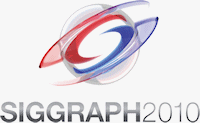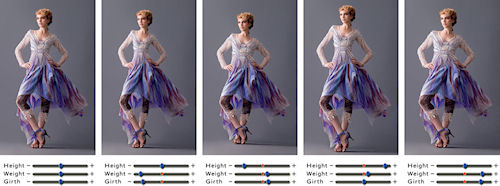 PRESS RELEASE: SIGGRAPH 2010 Technical Papers Focus on Technology and Advanced Techniques
PRESS RELEASE: SIGGRAPH 2010 Technical Papers Focus on Technology and Advanced Techniques
CHICAGO--(BUSINESS WIRE)--The SIGGRAPH 2010 Technical Papers program is the premier international forum for disseminating new scholarly work in computer graphics and interactive techniques. Topics range from a new application for browsing street-level imagery to new advancements in architecture demonstrating that curved surfaces can be just as rigid as traditional designs. A total of 390 submissions were reviewed by a distinguished panel of 49 jurors, and 103 papers were selected for presentation at SIGGRAPH 2010.
“SIGGRAPH 2010 will feature a vibrant field of technical presentations,” says Tony DeRose, SIGGRAPH 2010 Technical Papers Chair from Pixar Animation Studios. “We are most excited by the extraordinary breadth of topics as well as the fascinating achievements in many fields from architecture to photography.”
Papers cover core topics of computer graphics, such as modeling, animation, rendering, imaging, and human-computer interaction, and also explore related fields of audio, robotics, visualization, and perception. Presenters are from all around the globe—from Bangladesh to Switzerland.
Based upon the popularity of the program at SIGGRAPH 2009, this year’s Technical Papers program is once again expanding to include 33 conference presentations for each paper published this year in the journal ACM Transactions on Graphics (TOG). For the first time in SIGGRAPH’s history, the TOG Papers and the Technical Papers will be combined to create sessions with more coherent themes.
Listed below are a few highlights from the SIGGRAPH 2010 Technical Papers Program:
Street Slide: Browsing Street-Level Imagery
Street Slide is a novel browsing interface for street-level imagery that combines the best aspects of the immersive nature of bubbles with the overview provided by multi-perspective strip panoramas.
Authors: |
Johannes Kopf, Microsoft Research Redmond |
Billy Chen, Microsoft Corporation |
Richard Szeliski, Microsoft Research |
Michael F. Cohen, Microsoft Research |

|
Parametric Reshaping is a new technology being introduced at SIGGRAPH 2010 that allows even novice users to easily manipulate a subject's height, weight, and girth interactively while maintaining proportions.
Photo and caption provided by the Association for Computing Machinery / Business Wire. |
Parametric Reshaping of Human Bodies in Images
An easy-to-use image retouching system that allows users to easily reshape a human body in a single image by simply manipulating a small set of sliders corresponding to semantic attributes such as height, weight, and waist girth.
Authors: |
Shizhe Zhou, Zhejiang University |
Hongbo Fu, City University of Hong Kong |
Ligang Liu, Zhejiang University |
Daniel Cohen-Or, Tel-Aviv University |
Xiaoguang Han, Zhejiang University |
Video Tapestries with Continuous Temporal Zoom
A novel approach for summarizing video in the form of a multi-scale image that is continuous in both the spatial domain and across the scale dimension: there are no hard borders between moments in time, and one can zoom smoothly into the image to reveal additional temporal details.
Authors: |
Connelly Barnes, Princeton University |
Dan Goldman, Adobe Systems Incorporated |
Eli Shechtman, Adobe Systems Incorporated |
Adam Finkelstein, Princeton University |
The Frankencamera: An Experimental Platform for Computational Photography
Experimentation in computational photography is hindered by a lack of portable, flexible, and open photographic platforms. This paper presents Frankencamera, an architecture for programmable cameras, and demonstrates sample applications on two hardware implementations, a custom F2 camera and the Nokia N900 smartphone.
Authors: |
Andrew Adams, Stanford University |
Eino-Ville Talvala, Stanford University |
Sung Hee Park, Stanford University |
David E. Jacobs, Stanford University |
Boris Ajdin, Universität Ulm |
Natasha Gelfand, Nokia Research Center Palo Alto |
Jennifer Dolson, Stanford University |
Daniel Vaquero, University of California, Santa Barbara |
Jongmin Baek, Stanford University |
Marius Tico, Nokia Research Center Palo Alto |
Hendrik P. A. Lensch, Universität Ulm |
Wojciech Matusik, Disney Research Zürich |
Kari Pulli, Nokia Research Center Palo Alto |
Mark Horowitz, Stanford University |
Marc Levoy, Stanford University |
Multi-Scale Image Harmonization
Compositing images that differ significantly in appearance often produces unrealistic results. This framework matches the visual appearance of images, including contrast, texture, noise, and blur, by manipulating their pyramid representations and blends them with alpha-based and seamless boundary constraints to produce highly realistic composites with minimal user interaction.
Authors: |
Kalyan Sunkavalli, Harvard University |
Micah K. Johnson, Massachusetts Institute of Technology |
Wojciech Matusik, Disney Research |
Hanspeter Pfister, Harvard University |
OptiX: A General Purpose Ray Tracing Engine
This paper presents the design and implementation of the OptiX engine, a programmable architecture for interactive parallel ray tracing. By exposing a small set of programmable operations for ray generation, material shading, object intersection, and scene traversal, OptiX enables a diverse set of rendering and non-rendering algorithms.
Authors: |
Steven Parker, NVIDIA Corporation |
James Bigler, NVIDIA Corporation |
Andreas Dietrich, NVIDIA Corporation |
Heiko Friedrich, NVIDIA Corporation |
Jared Hoberock, NVIDIA Corporation |
David Luebke, NVIDIA Corporation |
David McAllister, NVIDIA Corporation |
Morgan McGuire, NVIDIA Corporation |
R. Keith Morley, NVIDIA Corporation |
Austin Robison, NVIDIA Corporation |
Martin Stich, NVIDIA Corporation |
A complete listing of all the papers presented in this year’s program will be available in late May at: http://www.siggraph.org/s2010/for_attendees/technical_papers.
About SIGGRAPH 2010
SIGGRAPH 2010 will bring approximately 25,000 computer graphics and interactive technology professionals from six continents to Los Angeles, California, USA for the industry's most respected technical and creative programs focusing on research, science, art, animation, music, gaming, interactivity, education, and the web from Sunday, 25 July through Thursday, 29 July 2010 at the Los Angeles Convention Center. SIGGRAPH 2010 includes a three-day exhibition of products and services from the computer graphics and interactive marketplace from 27-29 July 2010. More than 200 international exhibiting companies are expected. More details are available at www.siggraph.org/s2010
About ACM SIGGRAPH
The ACM Special Interest Group on Computer Graphics and Interactive Techniques www.siggraph.org, is an interdisciplinary community interested in research, technology, and applications in computer graphics and interactive techniques. Members include researchers, developers and users from the technical, academic, business, and art communities. SIGGRAPH provides information to the computer graphics community through its annual conference, publications and the SIGGRAPH Video Review.
About ACM
ACM, the Association for Computing Machinery www.acm.org, is the world's largest educational and scientific computing society, uniting educators, researchers and professionals to inspire dialogue, share resources and address the field's challenges. ACM strengthens the computing profession's collective voice through strong leadership, promotion of the highest standards, and recognition of technical excellence. ACM supports the professional growth of its members by providing opportunities for life-long learning, career development, and professional networking.
(First posted on Wednesday, May 12, 2010 at 14:24 EDT)